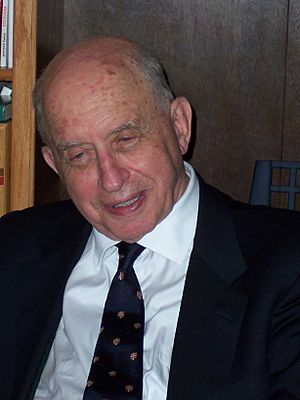Grigory Barenblatt facts for kids
Quick facts for kids
Grigory Barenblatt
|
|
|---|---|
| Григо́рий Исаа́кович Баренблатт | |
 |
|
| Born | July 10, 1927 |
| Died | June 22, 2018 (aged 90) |
| Nationality | Russian |
| Alma mater | Moscow State University (Ph.D) |
| Awards | Lagrange Medal (1995), G. I. Taylor Medal (1999), Timoshenko Medal (2005) |
| Scientific career | |
| Fields | Mathematics |
| Institutions | Shirshov Institute of Oceanology, Russian Academy of Sciences. University of California, Berkeley |
| Thesis | On the Motion of Suspended Particles in a Turbulent Flow (1953) |
| Doctoral advisor | Andrey Kolmogorov Boris Levitan |
Grigory Isaakovich Barenblatt (Russian: Григо́рий Исаа́кович Баренбла́тт; born July 10, 1927 – died June 22, 2018) was an important Russian mathematician. He made many big discoveries in how things move and break.
Education and Early Career
Grigory Barenblatt studied at Moscow State University, a famous university in Russia. He finished his first degree in 1950. Later, in 1953, he earned his Ph.D. (a high-level degree) from the same university. His main teacher for his Ph.D. was a well-known scientist named Andrey Kolmogorov.
In 1957, he received another advanced degree, a D.Sc., also from Moscow State University.
Research and Discoveries
Grigory Barenblatt was a respected professor at the University of California, Berkeley. He also worked as a mathematician at the Lawrence Berkeley National Laboratory. For a few years, from 1992 to 1994, he was a special professor at the University of Cambridge in England.
His research helped us understand many complex things. Here are some of the main areas he studied:
- Fracture Mechanics: This is about how materials break or crack. He studied how cracks grow and what makes them stop.
- Fluid and Gas Flow: He looked at how liquids and gases move, especially through materials with tiny holes, like sponges or rocks. This is called "porous media."
- Mechanics of Deformable Solids: This involves how solid objects change shape when forces are applied to them. He studied materials that behave in unusual ways.
- Turbulence: This is about messy, swirly movements in fluids, like smoke from a chimney or water in a fast river. He tried to understand these complex patterns.
- Self-similarities and Waves: He explored patterns that look the same at different scales. He also studied how waves move, especially "nonlinear waves" which are more complicated than simple waves.
Awards and Honors
Grigory Barenblatt received many awards for his important work. Here are some of them:
- 1975 – He became an Honorary Member of the American Academy of Arts and Sciences.
- 1984 – He became a Foreign Member of the Danish Center of Applied Mathematics & Mechanics.
- 1988 – He became a Foreign Member of the Polish Society of Theoretical & Applied Mechanics.
- 1989 – He received an honorary Doctor of Technology degree from the Royal Institute of Technology in Sweden.
- 1992 – He became a Foreign Associate of the U.S. National Academy of Engineering.
- 1993 – He became a Fellow of the Cambridge Philosophical Society.
- 1993 – He became a Member of Academia Europaea.
- 1994 – He became a Fellow at Gonville and Caius College, Cambridge.
- 1995 – He was awarded the Lagrange Medal.
- 1995 – He received the Modesto Panetti Prize and Medal.
- 1996 – He was a Visiting Professor at the University of California Berkeley.
- 1997 – He became a Foreign Associate of the U.S. National Academy of Sciences.
- 1999 – He received the G. I. Taylor Medal.
- 1999 – He was awarded the J. C. Maxwell Medal and Prize.
- 2000 – He became a Foreign Member of the Royal Society of London.
- 2005 – He received the Timoshenko Medal from the American Society of Mechanical Engineers. This award was for his big contributions to many areas of mechanics, including how things break, how fluids move, and how waves behave.
See also
 In Spanish: Grigori Barenblat para niños
In Spanish: Grigori Barenblat para niños

